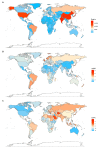Global Burden of Aortic Aneurysm and Attributable Risk Factors from 1990 to 2017
- PMID: 34040948
- PMCID: PMC8103850
- DOI: 10.5334/gh.920
Global Burden of Aortic Aneurysm and Attributable Risk Factors from 1990 to 2017
Abstract
Background: To date, our understanding of the global aortic aneurysm (AA) burden distribution is very limited.
Objective: To assess a full view of global AA burden distribution and attributable risk factors from 1990 to 2017.
Methods: We extracted data of AA deaths, disability-adjusted life years (DALYs), and their corresponding age-standardized rates (ASRs), in general and by age/sex from the 2017 Global Burden of Disease (GBD) study. The current AA burden distribution in 2017 and its changing trend from 1990 to 2017 were separately showed. The spatial divergence was discussed from four levels: global, five social-demographic index regions, 21 GBD regions, and 195 countries and territories. We also estimated the risk factors attributable to AA related deaths.
Results: Globally, the AA deaths were 167,249 with an age-standardized death rate (ASDR) of 2.19/100,000 persons in 2017, among which the elderly and the males accounted for the majority. Although reductions in ASRs were observed in developed areas, AA remained an important health issue in those relatively underdeveloped areas and might be much more important in the near future. AA may increasingly affect the elderly and the female population. Similar patterns of AA DALYs burden were noted during the study period. AA burden attributable to high blood pressure and smoking decreased globally and there were many heterogeneities in their distribution.
Discussion: AA maintained an incremental public health issue worldwide. The change pattern of AA burden was heterogeneous across locations, ages, and sexes and it is paramount to improve resource allocation for more effective and targeted prevention strategies. Also, prevention of tobacco consumption and blood pressure control should be emphasized.
Keywords: aortic aneurysm; deaths; disability-adjusted life years; global burden of disease; risk factors.
Copyright: © 2021 The Author(s).
Conflict of interest statement
The authors have no competing interests to declare.
Figures






Similar articles
-
The Global, Regional and National Burden of Pancreatic Cancer Attributable to Smoking, 1990 to 2019: A Systematic Analysis from the Global Burden of Disease Study 2019.Int J Environ Res Public Health. 2023 Jan 14;20(2):1552. doi: 10.3390/ijerph20021552. Int J Environ Res Public Health. 2023. PMID: 36674311 Free PMC article.
-
Smoking prevalence and attributable disease burden in 195 countries and territories, 1990-2015: a systematic analysis from the Global Burden of Disease Study 2015.Lancet. 2017 May 13;389(10082):1885-1906. doi: 10.1016/S0140-6736(17)30819-X. Epub 2017 Apr 5. Lancet. 2017. PMID: 28390697 Free PMC article.
-
Epidemiological trends of tracheal, bronchus, and lung cancer at the global, regional, and national levels: a population-based study.J Hematol Oncol. 2020 Jul 20;13(1):98. doi: 10.1186/s13045-020-00915-0. J Hematol Oncol. 2020. PMID: 32690044 Free PMC article.
-
Global, regional, and national burden of respiratory tract cancers and associated risk factors from 1990 to 2019: a systematic analysis for the Global Burden of Disease Study 2019.Lancet Respir Med. 2021 Sep;9(9):1030-1049. doi: 10.1016/S2213-2600(21)00164-8. Epub 2021 Aug 16. Lancet Respir Med. 2021. PMID: 34411511 Free PMC article.
-
Global, regional, and national burdens of leukemia from 1990 to 2017: a systematic analysis of the global burden of disease 2017 study.Aging (Albany NY). 2021 Apr 4;13(7):10468-10489. doi: 10.18632/aging.202809. Epub 2021 Apr 4. Aging (Albany NY). 2021. PMID: 33820874 Free PMC article.
Cited by
-
The burden of alcoholic cardiomyopathy in China and different regions around the world.J Glob Health. 2022 Jul 30;12:04041. doi: 10.7189/jogh.12.04041. J Glob Health. 2022. PMID: 35861492 Free PMC article.
-
AGGF1 therapy inhibits thoracic aortic aneurysms by enhancing integrin α7-mediated inhibition of TGF-β1 maturation and ERK1/2 signaling.Nat Commun. 2023 Apr 20;14(1):2265. doi: 10.1038/s41467-023-37809-x. Nat Commun. 2023. PMID: 37081014 Free PMC article.
-
Willingness to Receive mHealth Services Among Patients with Diabetes on Chronic Follow-up in Public Hospitals in Eastern Ethiopia: Multicenter Mixed-Method Study.Diabetes Metab Syndr Obes. 2023 Dec 13;16:4081-4099. doi: 10.2147/DMSO.S428210. eCollection 2023. Diabetes Metab Syndr Obes. 2023. PMID: 38111729 Free PMC article.
-
Restoring Vascular Smooth Muscle Cell Mitochondrial Function Attenuates Abdominal Aortic Aneurysm in Mice.Arterioscler Thromb Vasc Biol. 2025 Apr;45(4):523-540. doi: 10.1161/ATVBAHA.124.321730. Epub 2025 Feb 13. Arterioscler Thromb Vasc Biol. 2025. PMID: 39945066
-
Investigating long-term risk of aortic aneurysm and dissection from fluoroquinolones and the key contributing factors using machine learning methods.Sci Rep. 2025 Apr 16;15(1):13130. doi: 10.1038/s41598-025-97787-6. Sci Rep. 2025. PMID: 40240493 Free PMC article.
References
-
- Global, regional, and national disability-adjusted life-years (DALYs) for 359 diseases and injuries and healthy life expectancy (HALE) for 195 countries and territories, 1990–2017: A systematic analysis for the Global Burden of Disease Study 2017. Lancet (London, England). 2018; 392(10159): 1859–922. DOI: 10.1016/S0140-6736(18)32335-3 - DOI - PMC - PubMed
-
- Global, regional, and national comparative risk assessment of 84 behavioural, environmental and occupational, and metabolic risks or clusters of risks for 195 countries and territories, 1990–2017: A systematic analysis for the Global Burden of Disease Study 2017. Lancet (London, England). 2018; 392(10159): 1923–94. DOI: 10.1016/S0140-6736(18)32225-6 - DOI - PMC - PubMed
MeSH terms
LinkOut - more resources
Full Text Sources
Other Literature Sources
Medical

